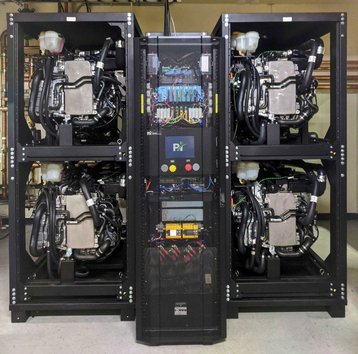Caterpillar and Microsoft say they have successfully demonstrated the viability of using hydrogen fuel cells to supply reliable and sustainable backup power to a data center for 48 hours.
Working with Ballard Power Systems, the companies used a large-format hydrogen fuel cell system to power Microsoft’s facility in Cheyenne, Wyoming, during a simulated two-day backup event.
Hydrogen fuel cell technology has been touted as a potential low-carbon replacement for diesel backup generators, but questions remain over the viability of the technology.
Microsoft and Caterpillar’s successful fuel cell experiment
The companies say the demonstration was “conducted in a challenging environment and validated the hydrogen fuel cell power system's performance at 6,086 ft (1,855 m) above sea level and in below-freezing conditions.”
The project simulated a 48-hour backup power event at the Cheyenne data center, where a hydrogen fuel cell was integrated into a data center electrical plant to support its critical load. A Caterpillar Microgrid Controller was used to operate two Cat Power Grid Stabilization (PGS) 1260 battery energy storage systems along with the 1.5MW hydrogen fuel cell from Ballard.
"This successful collaboration with Microsoft and Ballard demonstrates the potential of hydrogen fuel cells to help data centers address their critical power needs while reducing their emissions," said Jaime Mineart, senior vice president of Caterpillar Electric Power.
The project is “an important proof point of the reliability and durability of Ballard's fuel cells in providing zero-emission backup power for data centers," according to David Mucciacciaro, chief commercial officer of Ballard Power Systems. He added: "We are excited about the ability of our products to meet the critical power needs of data center customers in this rapidly growing sector."
Can hydrogen fuel cell technology replace diesel generators?
Microsoft, which has pledged to become carbon-negative by 2030, has been looking at the potential of hydrogen fuel cells for some time. In 2020, it powered a row of data center servers for 48 hours using a smaller 250kW fuel cell system.
This more recent project, which was conceived in 2021, takes the technology a step further, and has been supported and partially funded by the US Department of Energy Hydrogen and Fuel Cell Technologies Office (DOE) through its H2@Scale initiative.
While hydrogen fuel cell technology is advancing, significant barriers remain before it can be deployed at data centers. Hydrogen itself is currently much more expensive than diesel, and though the price is expected to drop in the next decade, it is also highly flammable and explosive, and thus requires complex - and costly - storage systems.
However, Sean James, senior director of data center research at Microsoft, said this latest demonstration “provides an opportunity for hyperscale providers to drive innovations in the sustainability of power generation technologies.”
James said: “The research and findings of the hydrogen fuel cell demonstration will help us towards our goal of becoming carbon negative by 2030."






